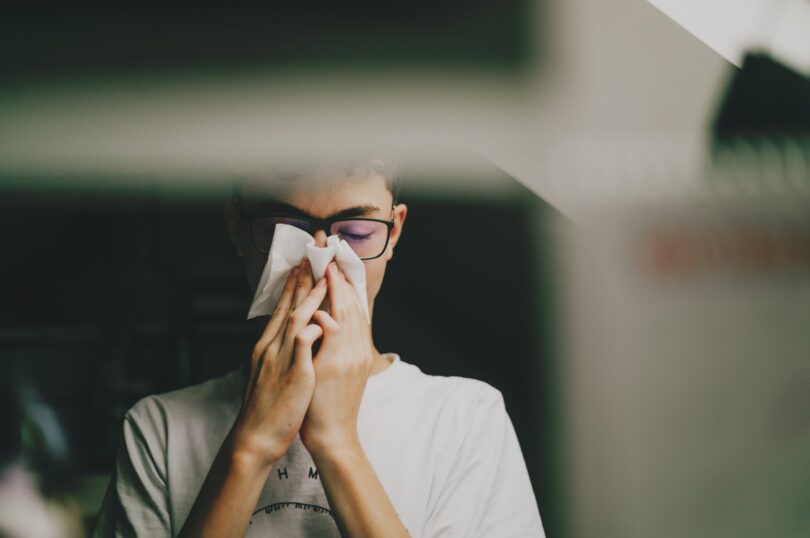ISTANBUL : Left and right, if not you, the people all around us are getting sick from the seasonal cold and flu. The conditions are ripe after the recent holiday celebrations brought people together to usher in a new year.
Couple that with the cold and wet weather bringing us all indoors when we socialize, and the recipe is ripe for a hefty serving of sniffles, sneezes, coughs, fevers, headaches and more.
Luckily, neuroscientist Andrew Huberman, whose HubermanLab is pretty much the most informative podcast to exist, has provided his listeners in his most recent episode with a lengthy list of preventative measures we can take to escape getting sick this winter.
How do we get colds and flu?
Common colds and flu are viral or bacterial infections that can spread between people and from surfaces. This we know, but what we may not know is precisely just how they spread, which is what Huberman breaks down for his listeners.
The most common way that people catch colds is by contracting a virus from surfaces or in the air when someone who is sick sneezes or coughs. Because we tend to spend more time indoors in the winter months, we are more exposed to other people’s sneezes or coughs that could be contagious.
Viruses are tiny, with each particle being approximately five microns, which calculates to 1/1000 of a centimeter. While they are tiny and can spread far, these particles are also heavy, which means they land on surfaces, either human or nonhuman.
The most common way of transmission of colds is the transfer of these particles from surfaces into our systems, which happens through our eyes, mouth and nose. Whereas, the most common way people contract the flu is from contact with someone contagious.
Not-so-fun facts:
– Contagious viruses for colds can survive on surfaces for up to 24 hours, whereas the flu virus lasts for approximately two hours.
– This means we can catch a cold or flu from the air or from touching someone who has the virus or touching a surface that has come into contact with the virus.
– Rubbing, wiping or touching our eyes is the most common way we self-infect with viruses.
– With the flu, the foremost form of transmission is human-to-human contact.
– Of note, surprisingly we tend to rub our eyes when we meet new people.
– The flu shot is 40% to 60% effective in reducing the risk of contracting certain flu strains and is said to decrease the effects of the flu when contracted.
– The second most common way we self-infect ourselves with the flu is by touching or breathing from our mouths.
– The nose is a lesser common way to contract a virus.

How long are we contagious?
We are contagious up to two days before we start showing symptoms, but we are the most contagious when we feel at our worst. We only start to not be contagious about five or six days past the peak of when we experienced symptoms. This means that during that time when we are contagious, so it is best to isolate so as not to infect others.
However, that is not always possible, so it becomes pertinent that we make sure to always carry and use tissues to suppress the spread of viruses through sneezes or coughs.
Both those who are sick and those who are not should wash their hands thoroughly after any incident of contact or use a disinfectant. But most importantly, if we can’t wash our hands immediately then we need to refrain from touching our own eyes, mouth and nose at any given time. We would all be surprised at how much we do touch our faces, alludes Huberman.
Preventative measures we can take
Of course, just coming into contact with a virus doesn’t necessarily mean one will catch it, especially if their immune system is strong in general.
So how can we make sure our immune system remains strong? Well, Huberman pinpoints these factors: get enough quality sleep, exercise regularly in the form of either moderate cardio and/ or weight training, have sufficient nutrition as in don’t be deficient in calories, eat pickles for good gut microbe and last, but not least, breathe through your nose.
Yes, it’s true, regular exercise boosts our immune system against viral infections. We should opt to get in 40 minutes to one hour of moderate exercise nearly every day to be at our optimal state of health. Dieting, or being in a deficit of calories, can suppress the immune system, so if you feel susceptible to a cold, you’ll want to ensure you are well-nourished.
Breathing through the nose, as in nasal breathing, is something we should all be opting for, the scientist concludes.
There are a lot of reasons nasal breathing is far superior to breathing through our mouths regularly and one reason is that breathing through our mouths increases the chances of ingesting a contagious virus, while breathing through our nose has the added benefit of an additional filtering mechanism should a virus enter that orifice.
Nasal breathing is also revered for decreasing stress, which is just another of the many reasons we should be opting to breathe through our nose.
Courtesy: Dailysabah







